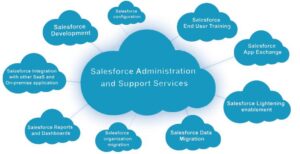
The Complete Guide to Data Management Software for Modern Businesses
Introduction to Data Management Software
In today’s digital-first world, businesses are generating more data than ever before. Every customer interaction, online transaction, and operational activity contributes to a massive pool of information. However, data on its own holds little value unless it is properly organized, stored, secured, and analyzed. This is where data management software comes in. It provides businesses with the ability to collect, process, and govern data efficiently while ensuring accuracy and accessibility. From startups to large enterprises, adopting the right software can significantly improve decision-making, compliance, and overall business performance.
What is Data Management Software?
Data management software refers to tools and platforms designed to handle the storage, organization, integration, and governance of data across multiple sources. It ensures that data remains accurate, accessible, and secure throughout its lifecycle. Unlike traditional spreadsheets or manual processes, modern data management solutions leverage automation, machine learning, and cloud technology to deliver real-time insights. Whether it is customer data, financial records, or product information, this software streamlines data handling for efficiency and reliability.
Why Data Management Software Matters
Businesses rely on data to guide strategic decisions, optimize operations, and enhance customer experiences. However, unmanaged data can lead to duplication, errors, compliance risks, and lost opportunities. Data management software solves these issues by offering:
-
Centralized Storage: It eliminates silos by integrating multiple sources into a single platform.
-
Improved Accuracy: Built-in validation reduces errors and inconsistencies.
-
Enhanced Security: Encryption, access control, and monitoring safeguard sensitive information.
-
Scalability: Modern platforms can grow with increasing data volumes.
-
Faster Insights: Real-time dashboards and analytics speed up decision-making.
Key Features of Data Management Software
To understand why companies are rapidly adopting such tools, it’s important to look at their core features:
1. Data Integration
Most businesses operate across multiple systems such as CRM, ERP, and e-commerce platforms. Data management software integrates all these sources, creating a unified view of information.
2. Data Quality Control
Data cleansing, deduplication, and enrichment features ensure that records remain consistent and trustworthy.
3. Security and Compliance
The software often comes with features like encryption, user authentication, role-based access, and audit trails, ensuring compliance with regulations like GDPR, HIPAA, or CCPA.
4. Metadata Management
It manages information about data, such as definitions, sources, and formats, improving transparency and usability.
5. Cloud and On-Premise Flexibility
Modern tools offer cloud-hosted options for scalability or on-premise installations for organizations with strict compliance needs.
6. Reporting and Analytics
Interactive dashboards and customizable reports make it easier to gain actionable insights.
Types of Data Management Software
There is no one-size-fits-all solution; different types of platforms are designed for specific business needs.
Database Management Systems (DBMS)
These are the most common, helping organizations store and manage large volumes of structured data. Examples include Microsoft SQL Server, Oracle, and MySQL.
Master Data Management (MDM)
MDM platforms ensure consistency across critical data such as customer records, product details, or supplier information.
Data Integration Tools
These tools focus on bringing data together from multiple sources and making it compatible for analysis. Popular examples include Talend and Informatica.
Data Governance Platforms
They emphasize compliance, transparency, and accountability in managing data.
Cloud Data Management Solutions
Platforms like Snowflake and AWS provide scalable, cloud-based solutions to handle massive datasets with high efficiency.
Benefits of Using Data Management Software
Adopting a robust system brings numerous advantages:
-
Operational Efficiency: Reduces manual work and eliminates redundancies.
-
Better Decision-Making: Provides reliable and real-time data insights.
-
Regulatory Compliance: Helps avoid fines by ensuring adherence to laws.
-
Customer Experience: Improves personalization by providing accurate customer data.
-
Cost Savings: Minimizes the need for repetitive work and prevents costly errors.
-
Competitive Advantage: Data-driven companies stay ahead by identifying trends and opportunities faster.
Challenges in Data Management and How Software Solves Them
Data Silos
Departments often work in isolation, leading to fragmented data. Software integrates data across systems, creating a single source of truth.
Data Quality Issues
Inconsistent, incomplete, or duplicate records reduce trust. Data cleansing features help maintain accuracy.
Security Risks
Cyberattacks and breaches are rising. Advanced encryption and monitoring features strengthen defense.
Scalability Problems
As businesses grow, so does data. Cloud-based platforms ensure that the system can handle future growth without performance issues.
Compliance Pressures
Regulatory environments keep evolving. Software with built-in compliance frameworks helps businesses stay aligned with regulations.
How to Choose the Right Data Management Software
When selecting the best platform, businesses must consider:
-
Business Needs: Identify whether you need a general DBMS, MDM, or a cloud-based solution.
-
Scalability: Choose software that can grow with your data demands.
-
Ease of Use: A user-friendly interface ensures wider adoption across teams.
-
Integration Capabilities: Ensure compatibility with existing systems like CRM or ERP.
-
Security Features: Look for encryption, access controls, and compliance certifications.
-
Support and Training: Strong vendor support is essential for long-term success.
-
Cost: Balance features with budget constraints and long-term ROI.
Top Data Management Software Solutions in 2025
Here are some of the most widely used tools:
-
Oracle Database: A powerful DBMS for enterprises with complex data requirements.
-
Microsoft SQL Server: Known for its scalability and integration with Microsoft tools.
-
Snowflake: A cloud-native platform for analytics and big data management.
-
Informatica: Leading in data integration and governance solutions.
-
Talend: An open-source platform with strong integration and transformation capabilities.
-
IBM InfoSphere: Robust features for data governance and quality.
-
SAP Master Data Governance: Focused on enterprise-scale master data management.
The Role of AI and Machine Learning in Data Management Software
Artificial Intelligence (AI) and Machine Learning (ML) are revolutionizing data management by:
-
Automating data cleansing and enrichment.
-
Predicting anomalies and potential security threats.
-
Enhancing predictive analytics for business forecasting.
-
Improving metadata management with natural language processing.
AI-powered data management software reduces manual intervention while increasing accuracy and efficiency.
The Future of Data Management Software
The future is heading toward intelligent, autonomous data platforms. Some trends include:
-
Self-Service Data Management: Allowing non-technical users to handle data independently.
-
Real-Time Data Processing: With IoT and edge computing, instant data insights will become crucial.
-
Blockchain for Data Integrity: Ensuring tamper-proof records and transparency.
-
Greater Emphasis on Privacy: Software will continue adapting to stricter global data protection regulations.
-
Hybrid Data Management: Combining cloud and on-premise solutions for flexibility.
Best Practices for Implementing Data Management Software
-
Define Clear Goals: Know what business outcomes you want to achieve.
-
Clean Data Before Migration: Ensure data is consistent before moving into the system.
-
Train Employees: Adoption is easier when employees understand how to use the tool effectively.
-
Monitor Performance: Continuously assess data quality and system efficiency.
-
Update Security Protocols: Regular updates and audits are essential.
Case Study Example
A retail company managing thousands of daily transactions struggled with inconsistent customer data spread across multiple platforms. By implementing a cloud-based data management software, they integrated customer records, reduced duplication by 70%, and improved targeted marketing campaigns. Within six months, the company reported a 25% increase in customer retention and faster decision-making across departments. This highlights how the right solution can deliver measurable business results.
Conclusion
Data is one of the most valuable assets in today’s business world. However, without proper management, it can quickly become a burden. Data management software offers the tools and technologies needed to transform raw information into actionable insights, improve compliance, and secure sensitive information. From startups seeking to organize their data to global enterprises dealing with complex infrastructures, the right platform ensures that data is accurate, accessible, and future-ready. As the digital landscape evolves, businesses that invest in robust data management solutions will undoubtedly stay ahead of competitors, making smarter decisions, and building stronger customer relationships.





